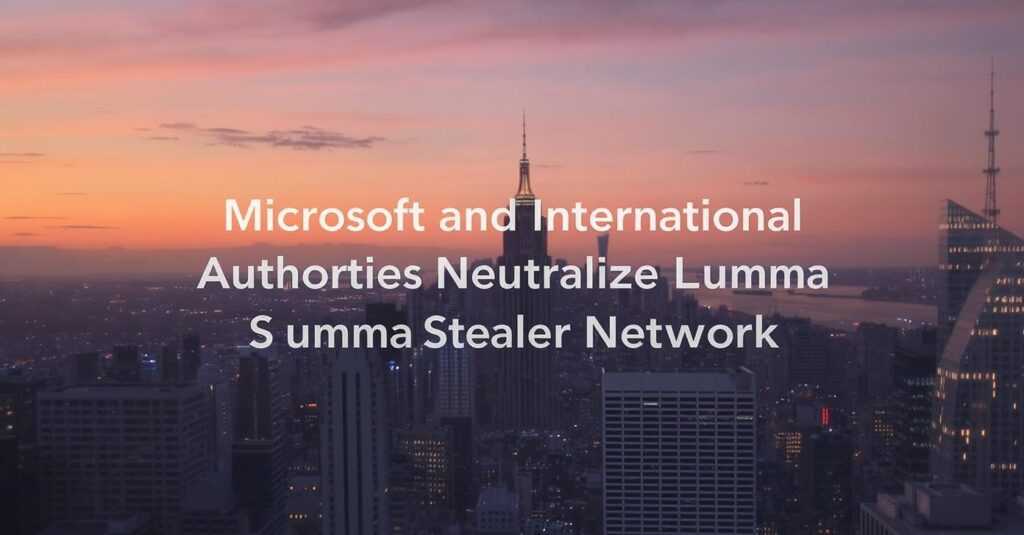In a landmark victory for the global cybersecurity community, Microsoft and Global Authorities dismantle Lumma Stealer malware network, ending the reign of one of the most dangerous malware-as-a-service (MaaS) platforms to date. The coordinated operation brought together government agencies, private-sector cybersecurity teams, and legal enforcement from multiple countries to identify, disrupt, and disable the sophisticated infrastructure behind Lumma Stealer.
This takedown highlights the new-age approach to fighting cybercrime—unified, intelligence-led, and laser-focused on dismantling malicious digital ecosystems that threaten governments, corporations, and consumers alike. The success is a pivotal moment for cyber defense in an increasingly interconnected and vulnerable digital world.
What Is Lumma Stealer?
Lumma Stealer is a powerful information-stealing malware designed to extract sensitive data from infected systems. Commonly distributed through phishing emails, cracked software, and drive-by downloads, Lumma’s malicious payload targets credentials, browser cookies, crypto wallet information, and system configurations. Once inside a system, the malware communicates with a remote command-and-control (C2) server, exfiltrating data while maintaining a low profile.
Its modular architecture, ease of deployment, and constant feature upgrades made Lumma Stealer a favored tool in the underground economy. Distributed under a subscription-based MaaS model, it allowed even inexperienced actors to carry out damaging cyberattacks. The sheer accessibility and reliability of the malware created a growing threat that demanded international intervention.
Microsoft Leads the Fight
Microsoft and global authorities dismantle Lumma Stealer malware network after months of intelligence gathering, system monitoring, and collaboration with international law enforcement. Microsoft’s Threat Intelligence Center (MSTIC) and Digital Crimes Unit (DCU) were instrumental in this process.
By leveraging telemetry data from Microsoft Defender for Endpoint, Defender for Office 365, and Azure Sentinel, the company was able to map Lumma’s digital footprint and uncover the infrastructure supporting its spread. Analysts reverse-engineered malware samples and correlated attack campaigns using machine learning, identifying key operators, server clusters, and compromised domains.
Microsoft’s legal and cyber-forensic experts worked in parallel with authorities to secure court orders that allowed seizure of C2 domains and shutdown of data exfiltration pipelines, severely crippling the malware’s operation.
A Global Enforcement Operation
The success of this operation wouldn’t have been possible without a joint law enforcement coalition. Agencies involved included:
FBI Cyber Division
Europol’s European Cybercrime Centre (EC3)
Interpol’s Cybercrime Directorate
United Kingdom’s National Crime Agency (NCA)
Australia’s Cyber Security Centre (ACSC)
German Federal Criminal Police Office (BKA)
Canadian Centre for Cyber Security
These agencies executed synchronized raids and digital interventions across multiple jurisdictions. In several cases, server infrastructure was seized physically, and associated assets—cryptocurrency wallets, dark web vendor accounts, and exploit toolkits—were confiscated for evidence.
How the Network Operated
The Lumma Stealer malware network relied on an international network of rented servers, bulletproof hosting providers, and obfuscated domain registrars. The developers employed encryption protocols and randomized infrastructure configurations to evade detection. Malware operators often used Tor and VPNs to anonymize their communications and managed infected systems via web-based dashboards.
With the network now dismantled, Microsoft and global authorities dismantle Lumma Stealer malware network that had been growing silently behind firewalls and antivirus layers, slipping through unpatched systems and careless configurations across businesses globally.
Why This Takedown Matters
Lumma Stealer had infected tens of thousands of endpoints globally, many within enterprise environments. Victims unknowingly had their credentials, documents, and private data harvested, potentially leading to account takeovers, corporate espionage, financial theft, and even regulatory violations.
Now that Microsoft and global authorities dismantle Lumma Stealer malware network, businesses and individuals previously affected have an opportunity to reassess their cybersecurity posture. Threat actors who relied on Lumma’s MaaS platform for cheap and scalable attacks will need to seek alternatives, many of which are not yet as robust or as widely distributed.
The Malware-as-a-Service Ecosystem
MaaS platforms like Lumma Stealer represent a disturbing evolution in cybercrime. Instead of writing malware, attackers can rent it—complete with documentation, customer support, and update logs. Just as cloud computing transformed business operations, MaaS transformed cyberattacks, lowering the barrier to entry and increasing the scale of damage.
With this takedown, Microsoft and global authorities dismantle Lumma Stealer malware network, undermining confidence in these services and sending a warning to similar operators that they too are being watched.
The Role of Threat Intelligence Sharing
A critical factor in the takedown’s success was Microsoft’s real-time threat intelligence sharing with government agencies and cybersecurity firms. By tracking indicators of compromise (IOCs), suspicious IP addresses, domain registries, and C2 protocols, analysts created a full picture of Lumma’s lifecycle.
Data sharing alliances such as the Joint Cyber Defense Collaborative (JCDC), Cyber Threat Alliance (CTA), and Microsoft’s own partner ecosystem helped widen the visibility of the attack pattern, ensuring that no actor or system was left behind.
Enterprise-Level Implications
For enterprises, this moment is both a relief and a wake-up call. Microsoft and global authorities dismantle Lumma Stealer malware network, but there are still countless other threats waiting to exploit the same vulnerabilities. Security professionals must now:
Review endpoint protection policies
Enforce multi-factor authentication
Audit third-party application access
Re-educate employees on phishing and social engineering
Deploy modern XDR and SIEM tools
The incident also reiterates the need for a Zero Trust architecture—assuming breach, verifying every user and endpoint, and granting only minimum necessary access.
Recommendations for Security Teams
Now that Microsoft and global authorities dismantle Lumma Stealer malware network, enterprise CISOs and IT leaders should act swiftly to secure their environments and prevent recurrence. Recommended steps include:
Patch Management: Ensure all operating systems, browsers, and plugins are fully updated to prevent exploitation.
Threat Detection and Response: Utilize tools like Microsoft Defender for Endpoint and Sentinel for early alerting and automated response.
Security Awareness Training: Teach users to spot phishing attempts, suspicious downloads, and compromised websites.
Review of Credential Hygiene: Enforce strong passwords, monitor reuse, and integrate credential vaults for password management.
Engage with Threat Intelligence Feeds: Subscribe to actionable threat feeds from trusted vendors and industry alliances.
A Blueprint for Future Operations
The Lumma Stealer takedown sets a powerful precedent for how public-private partnerships can be mobilized to neutralize global digital threats. Microsoft’s use of AI, data science, and advanced telemetry provides a template for other security vendors aiming to play a role in large-scale cybercrime mitigation.
Meanwhile, law enforcement has shown that even anonymous dark web actors cannot hide indefinitely. Through coordination, legal action, and persistent intelligence gathering, it is possible to uncover and disrupt even the most evasive cybercrime networks.
Read Full Article : https://bizinfopro.com/news/it-news/microsoft-and-global-authorities-dismantle-lumma-stealer-malware-network-2/
About Us : BizInfoPro is a modern business publication designed to inform, inspire, and empower decision-makers, entrepreneurs, and forward-thinking professionals. With a focus on practical insights and in‑depth analysis, it explores the evolving landscape of global business—covering emerging markets, industry innovations, strategic growth opportunities, and actionable content that supports smarter decision‑making.



